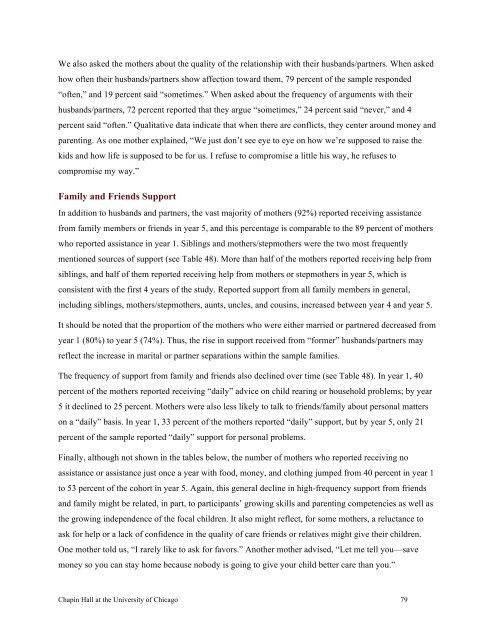2011 The Palm Beach County Family Study (Full Report)
2011 The Palm Beach County Family Study (Full Report)
2011 The Palm Beach County Family Study (Full Report)
- No tags were found...
Create successful ePaper yourself
Turn your PDF publications into a flip-book with our unique Google optimized e-Paper software.
We also asked the mothers about the quality of the relationship with their husbands/partners. When askedhow often their husbands/partners show affection toward them, 79 percent of the sample responded“often,” and 19 percent said “sometimes.” When asked about the frequency of arguments with theirhusbands/partners, 72 percent reported that they argue “sometimes,” 24 percent said “never,” and 4percent said “often.” Qualitative data indicate that when there are conflicts, they center around money andparenting. As one mother explained, “We just don’t see eye to eye on how we’re supposed to raise thekids and how life is supposed to be for us. I refuse to compromise a little his way, he refuses tocompromise my way.”<strong>Family</strong> and Friends SupportIn addition to husbands and partners, the vast majority of mothers (92%) reported receiving assistancefrom family members or friends in year 5, and this percentage is comparable to the 89 percent of motherswho reported assistance in year 1. Siblings and mothers/stepmothers were the two most frequentlymentioned sources of support (see Table 48). More than half of the mothers reported receiving help fromsiblings, and half of them reported receiving help from mothers or stepmothers in year 5, which isconsistent with the first 4 years of the study. <strong>Report</strong>ed support from all family members in general,including siblings, mothers/stepmothers, aunts, uncles, and cousins, increased between year 4 and year 5.It should be noted that the proportion of the mothers who were either married or partnered decreased fromyear 1 (80%) to year 5 (74%). Thus, the rise in support received from “former” husbands/partners mayreflect the increase in marital or partner separations within the sample families.<strong>The</strong> frequency of support from family and friends also declined over time (see Table 48). In year 1, 40percent of the mothers reported receiving “daily” advice on child rearing or household problems; by year5 it declined to 25 percent. Mothers were also less likely to talk to friends/family about personal matterson a “daily” basis. In year 1, 33 percent of the mothers reported “daily” support, but by year 5, only 21percent of the sample reported “daily” support for personal problems.Finally, although not shown in the tables below, the number of mothers who reported receiving noassistance or assistance just once a year with food, money, and clothing jumped from 40 percent in year 1to 53 percent of the cohort in year 5. Again, this general decline in high-frequency support from friendsand family might be related, in part, to participants’ growing skills and parenting competencies as well asthe growing independence of the focal children. It also might reflect, for some mothers, a reluctance toask for help or a lack of confidence in the quality of care friends or relatives might give their children.One mother told us, “I rarely like to ask for favors.” Another mother advised, “Let me tell you—savemoney so you can stay home because nobody is going to give your child better care than you.”Chapin Hall at the University of Chicago 79
















